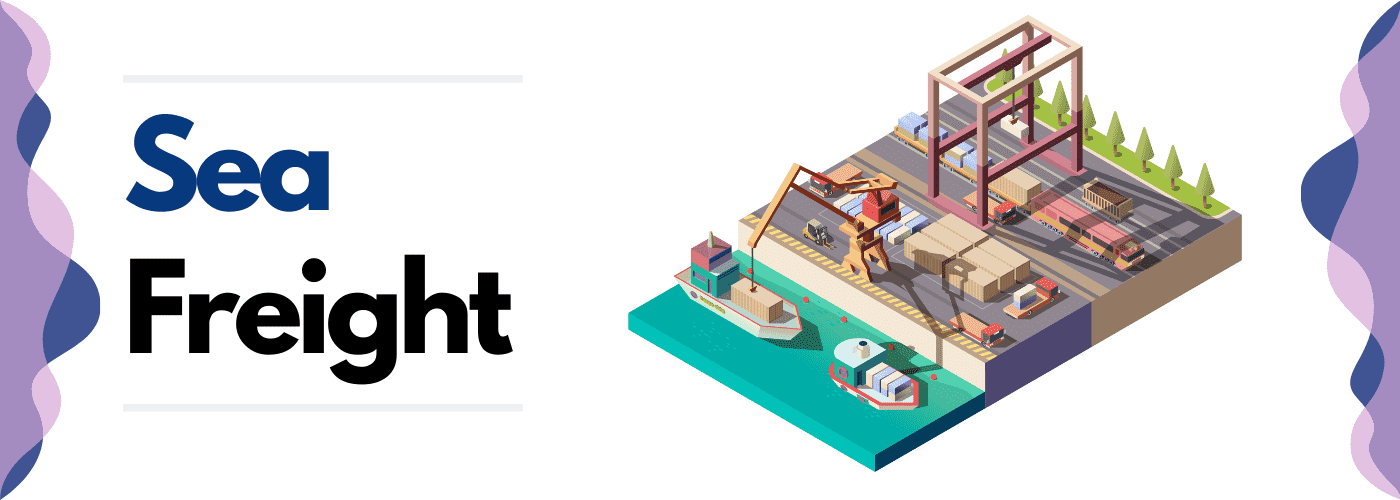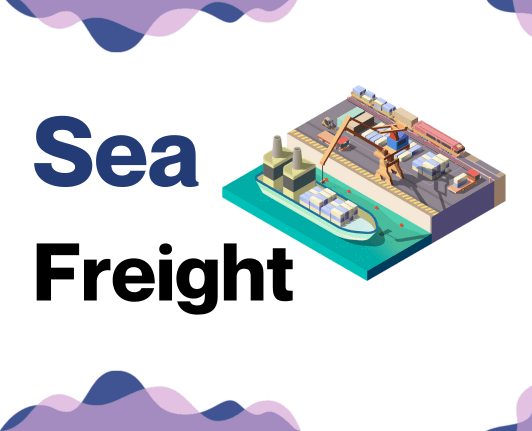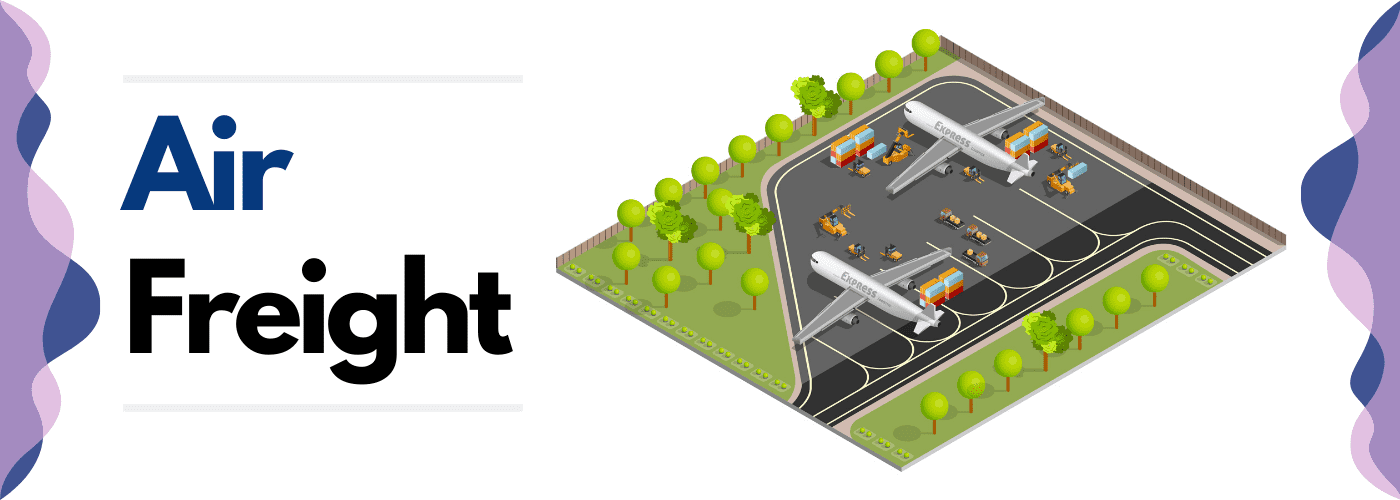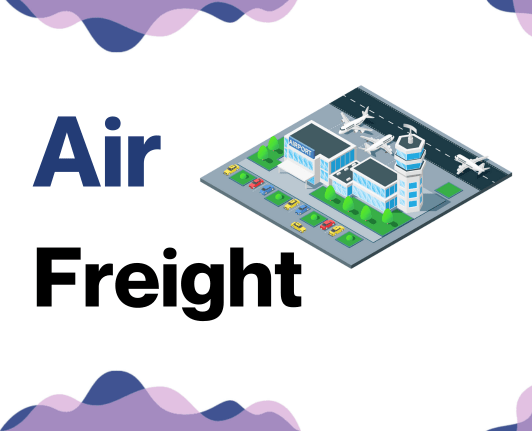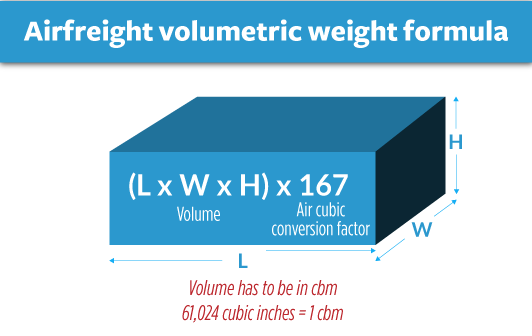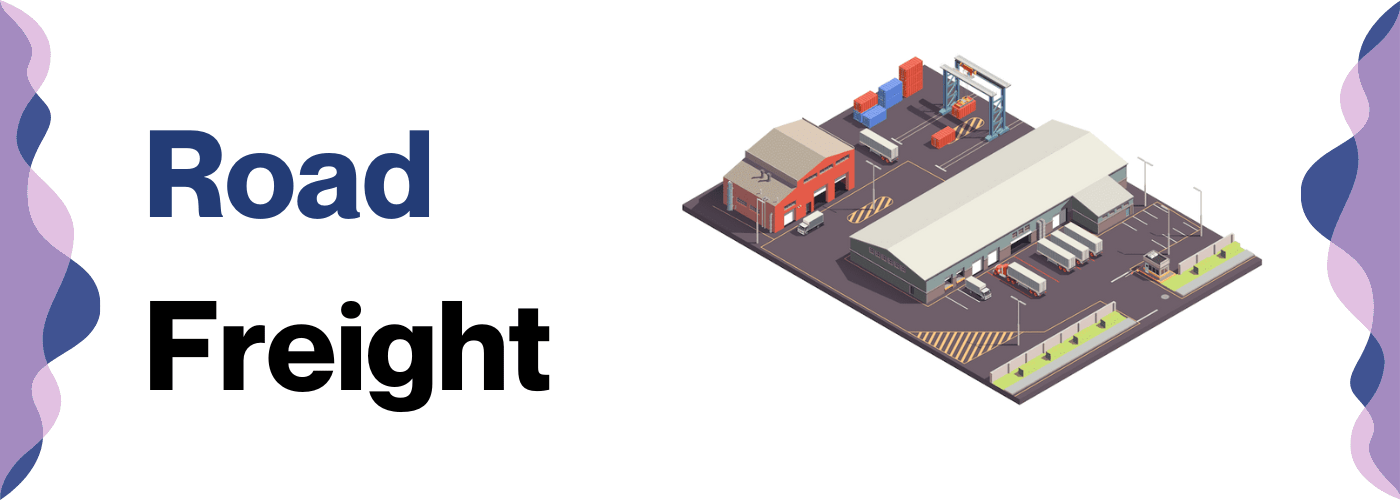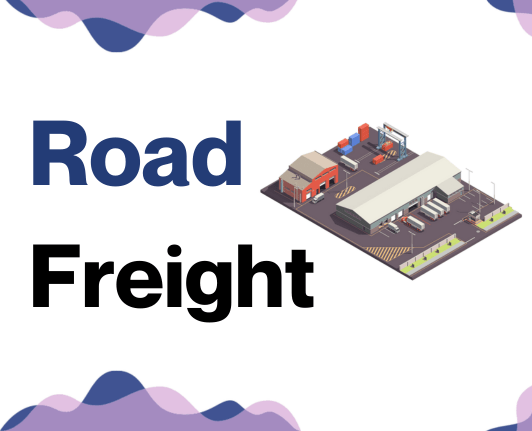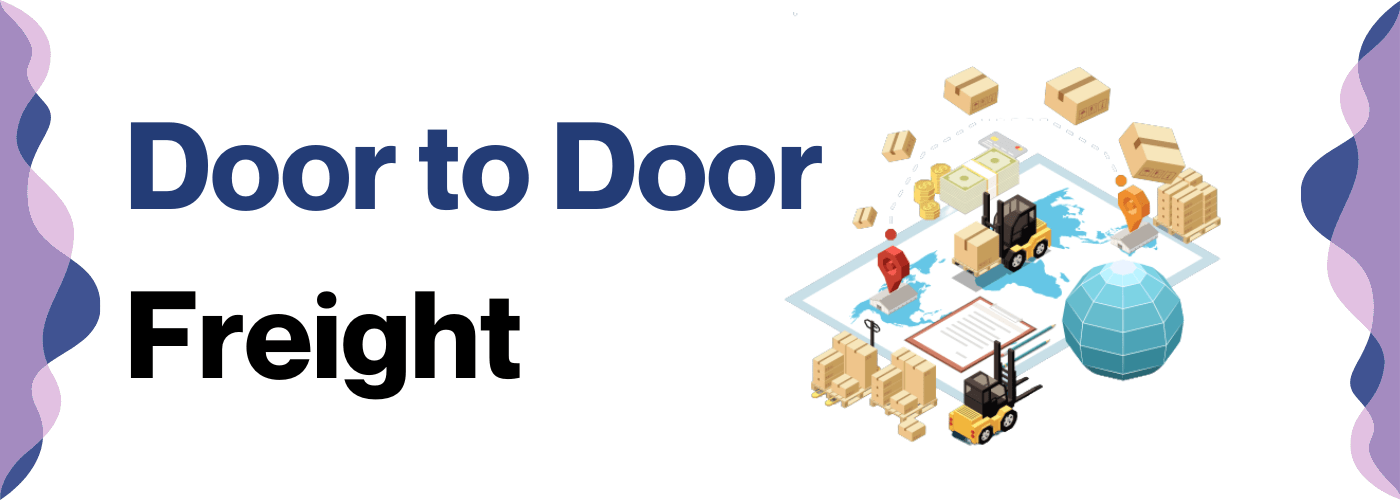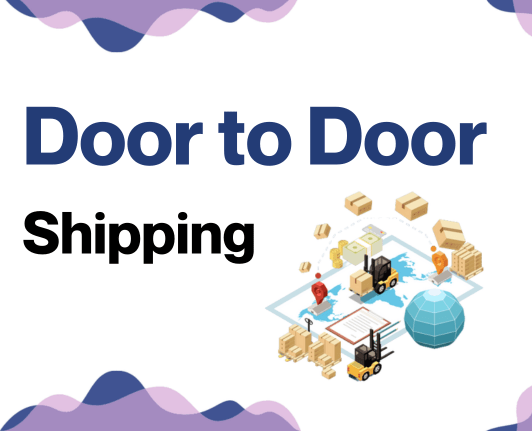Who said shipping freight from the UK to Poland had to be as complicated as making pierogies from scratch?
Understanding freight transport rates, estimated delivery times, and navigating through customs regulations can feel just as involved. This guide aims to simplify the process by clarifying the most critical points. From laying out different freight options–air, sea, road, or rail–to demystifying the complexities of customs clearance, duties, and taxes, we aim to provide a comprehensive resource for businesses.
Our guide also includes tailored advice to help you make the most informed decisions. If the process still feels overwhelming, let DocShipper handle it for you! As an international freight forwarder, we diligently manage every step of the shipping process, turning potential challenges into successful shipments. So sit back, relax, and dive into our guide as we take freight-forwarding from a headache to a piece of cake.
Table of Contents
Which are the different modes of transportation between UK and Poland?
Choosing the right transport method between the UK and Poland narrows down to understanding your unique shipping needs and being aware of the geographical distance and international borders between these two countries. Landlocked nations aren't on our path, so road and rail freight are workable options. But, surprise, you'll have the North Sea to sail through if sea freight tickles your fancy. For speedy deliveries, air freight swoops in to save the day. It's like picking your favourite meal - it all depends on your appetite, in this case for speed, capacity, and cost!
How can DocShipper help?
Whether by air, sea, or road, shipping goods from UK to Poland has never been easier with DocShipper. Our expert team arranges everything from transport to customs, ensuring a hassle-free experience. Got a query? Don't hesitate- reach out to our consultants. Ready for a quick, free estimate? Make the smart move and contact us today. Your shipment is our priority.
DocShipper Tip: Ocean freight might be the best solution for you if:
- You're dealing with large quantities or oversized items. Sea freight offers a budget-friendly way to maximize space, a particularly useful option given the UK's extensive port network.
- Your shipment isn't on a tight schedule. Ocean transport typically takes longer than air or rail, but it offers reliability.
- Your supply chain involves key ports, allowing you to take advantage of a wide-reaching network of sea lanes.
Sea freight between UK and Poland
As a thriving trade corridor, the UK-Poland route opens an array of opportunities in ocean freight, linking prime industrial centers through pivotal cargo ports, Southampton and Gdansk, to name a few. Choosing this transit mode, auspicious for large-volume goods, can unlock a cost-efficient gateway, albeit the slowest compared to other methods.
That said, the journey isn't always smooth sailing. An unforeseen sea of complex regulations and overlooked details often leaves shippers feeling unanchored. Mistakes become costly lessons, and the journey can seem more like crossing an ocean than navigating a harbor. But don't throw in the shipping towel. Harness effective practices and specifications, akin to assembling the right tool kit for this maritime voyage. We'll be your strategic compass, providing practical insights for a hassle-free shipping experience. Think of this as having a trusted friend who's already sailed these waters guide you through every ripple and wave. Together, we'll turn challenges into favorable tides.
Main shipping ports in UK
Port of London
Location and Volume: Located on the River Thames, this port is fundamental for UK's trade as it is the second largest in the country, with a shipping volume of 53 million tonnes annually.
Key Trading Partners and Strategic Importance: The port has extensive connections with Europe, Asia, and the Americas. It's recognized for handling every type of cargo, including containers, bulk goods, and oil.
Context for Businesses: If you're planning to expand to Europe, Asia, or America, the Port of London, due to its strategic location and capability of handling diverse types of cargo, could work as a key element in your logistics strategy.
Port of Liverpool
Location and Volume: Occupying the Western coast of the country, this port is responsible for more than 32 million tonnes of cargo annually.
Key Trading Partners and Strategic Importance: The port maintains strong ties with America, Asia, and other European countries. It is well-known for its large and sophisticated container terminal.
Context for Businesses: If your business requires diverse connections and heavy container shipping, the Port of Liverpool could be the perfect fit, considering its world-class container terminal and wide range of connections.
Port of Southampton
Location and Volume: Located on the South Coast, this port handles over 40 million tonnes of cargo annually.
Key Trading Partners and Strategic Importance: It sustains partnerships primarily with Europe, North America, and the Far East. Importantly, it's the UK’s leading port for automotive trade.
Context for Businesses: For companies within the automotive sector intending to penetrate European, American, or Far Eastern markets, the Port of Southampton could be an important enabler, due to its advanced automotive handling facilities.
Port of Dover
Location and Volume: Based in the Southeastern part of the UK, this port manages upwards of 5.4 million TEU annually.
Key Trading Partners and Strategic Importance: Vital to the UK-EU trade corridor, it maintains strong connections with France and Belgium. It is renowned for handling roll-on/roll-off traffic.
Context for Businesses: If your business model relies heavily on roll-on/roll-off shipping or you're looking to boost your trade with France or Belgium, the Port of Dover's capabilities could significantly benefit your distribution strategy.
Port of Grimsby & Immingham
Location and Volume: Located on the Humber Estuary in England, this port handles more than 5 million tonnes of cargo annually.
Key Trading Partners and Strategic Importance: The port trades mostly with Europe and North America. It's a leading port for energy products, especially in coal and oil import/export.
Context for Businesses: Companies in the energy sector, particularly those dealing with coal and oil, might find an advantage in the Port of Grimsby & Immingham's robust infrastructure and strategic trading position.
Port of Felixstowe
Location and Volume: Situated in Suffolk, this port is one of the largest in the UK with a shipping volume of about 3.8 million TEU annually.
Key Trading Partners and Strategic Importance: It accommodates a large part of the UK’s trading activities, particularly with the Far East, North America, and European countries. It holds the title for the UK's busiest container port.
Context for Businesses: Businesses heavily reliant on container shipping, especially those focusing on Far Eastern, North American, and European markets, might want to consider the Port of Felixstowe for its major container handling capability.
Main shipping ports in Poland
Port of Gdansk
Location and Volume: The Port of Gdansk is situated on the southern coast of the Baltic Sea. As the largest port in Poland, it is instrumental in European trade with a shipping volume of more 48.5 million tonnes per year.
Key Trading Partners and Strategic Importance: The port has a wide array of trading partners, with the primary ones being Russia, Germany, Sweden, the United States, and China. Its strategic location on the Baltic sea provides direct maritime links with Nordic countries, enhancing Poland's northern trade route.
Context for Businesses: If your company is looking at expanding trading activities with northern Europe and Russia, the Port of Gdansk could prove a vital conduit due to its favourable location and massive shipment capacities.
Port of Gdynia
Location and Volume: Located near Gdansk on the Baltic Sea's southern coast, the Port of Gdynia is Poland’s second most significant port with a handling volume of over 21 million tonnes per year.
Key Trading Partners and Strategic Importance: Primary trading partners include Germany, India, China, Russia, Sweden, and the Netherlands. The port's strategic location enhances Nordic traffic, especially with Sweden.
Context for Businesses: If you're interested in heavy-load or bulk cargo shipping, the Port of Gdynia is a beneficial option due to its efficient handling capacities and strong connectivity with the rest of Europe.
Port of Szczecin
Location and Volume: Situated on the Oder River, which extends into the Baltic Sea, the Port of Szczecin boasts a shipment volume exceeding 23 million tonnes per year.
Key Trading Partners and Strategic Importance: Key trading nations consist of Belgium, Germany, Holland, Russia, and the UK. The port excels in handling general cargo, coal, and containers, indicating a diversified trade portfolio.
Context for Businesses: If your business model involves multitude of goods types, the Port of Szczecin, with its versatility in operations, can be an integral part of your shipping strategies.
Port of Swinoujscie
Location and Volume: Located near the German border at the Szczecin lagoon, the Port of Swinoujscie is Poland's fourth major port. Per year, it handles over 31 million tonnes of goods.
Key Trading Partners and Strategic Importance: Key trade partners include Sweden, the Netherlands, Germany, and Finland. Its geographic location at the German-Polish border gives it strategic significance as an international trade hub.
Context for Businesses: If you're looking to expand trading activities with Germany or enhance Western European links, incorporating the Port of Swinoujscie into your shipping arrangements can be highly beneficial due to its strategic location.
Should I choose FCL or LCL when shipping between UK and Poland?
Choosing between Full Container Load (FCL) and Less-than Container Load (LCL), also known as consolidation, heavily influences the success of shipping goods from the UK to Poland. What hangs in the balance? Your budget, delivery timelines, and ultimately, the smooth transit of your goods. But don't fret! We're here to decode these jargons and guide you in making an informed decision. Prepared to dive in and learn the ins and outs of sea freight options? Let's embark on this journey together!
LCL: Less than Container Load
Definition: Less than Container Load (LCL) shipping is a cost-effective method of transporting goods when your cargo does not fill an entire container. It combines shipments from multiple shippers in one container, yielding lower costs.
When to Use: If your shipment is less than 15 cubic meters (CBM), LCL might be your best choice for shipping between the UK and Poland. This provides flexibility in terms of cost and shipment size, ideal for low volume shipments.
Example: Imagine you're a UK manufacturer exporting 10 CBM of automotive parts to Poland. Shipping a full 20-foot container might be unnecessarily costly considering its unused space. Instead, using LCL, you can share the container (and the cost) with other shippers, making it a more cost-effective and rational choice.
Cost Implications: LCL saves money by only paying for the space you use. However, it may also involve additional costs, like consolidation and deconsolidation fees. Yet, for cargo between 13 and 15 CBM, these fees are typically outweighed by the savings from not booking a full container, making LCL freight an economically smart decision for smaller shipments.
FCL: Full Container Load
Definition: FCL (Full Container Load) shipping is a type of sea freight where you reserve a whole container (20'ft or 40'ft in size) exclusively for your goods.
When to Use: If your cargo volume surpasses 13, 14 or 15 CBM (Cubic Meter), FCL will be an ideal choice. It offers both cost-effectiveness for high volume shipments and the security of having your goods sealed from their origin all the way to the destination.
Example: So, if your business is importing a bulk order of furniture pieces from Poland to the UK, sufficient to fill a 20'ft container, opting for FCL shipping will be the smart move. Your furniture would be securely stowed inside the container and won't be opened until it arrives in the UK, ensuring greater safety.
Cost Implications: While an FCL shipping quote might initially seem steep, its per unit cost decreases significantly with a larger volume. This is due to the fixed basic costs of the sea passage, handling, and container use. Hence, in comparison with LCL (Less than Container Load) or other freight options, FCL becomes cheaper for high volume shipments.
Unlock hassle-free shipping
Confused about choosing between consolidation or a full container for your UK-Poland shipping? You're not alone. That's what DocShipper is here for. Our ocean freight experts simplify this choice by weighing factors such as your budget, cargo volume, and delivery urgency. Making cargo shipping hassle-free is our mission. Keen to unravel the complexities of international shipping? Contact us today for a free cost estimation. Let's shift your shipping dilemma into an advantage.
How long does sea freight take between UK and Poland?
On average, sea freight between the UK and Poland takes about 3-7 days. This estimation is influenced by factors like the choice of ports, weight of the goods, and their nature – be it hazardous, oversized, or standard. For a more accurate timeframe tailored to your needs, we recommend contacting a freight forwarder, such as DocShipper.
| UK (Ports) | Poland (Ports) | Average Transit Time (Days) |
| Dover | Gdansk | 5 |
| Felixstowe | Gdynia | 5 |
| London Gateway | Szczecin | 16 |
| Southampton | Świnoujście | 16 |
*Bear in mind, these are average transit times and might vary based on factors discussed earlier.
How much does it cost to ship a container between UK and Poland?
Determining the exact shipping cost from the UK to Poland can be a bit like assembling a jigsaw puzzle. Ocean freight rates, for instance, could range widely per CBM due to multiple variables. The Point of Loading, destination, the carrier involved, the nature of your goods, and even monthly market shifts can significantly affect the final quotation. But don't let this deviation unsettle you. Our seasoned shipping specialists are on standby to piece together all these elements. By tailoring our approach to your unique requirements, we ensure you receive the optimum rate possible every time.
Special transportation services
Out of Gauge (OOG) Container
Definition: OOG Containers are specially designed for items that exceed the dimensions of a standard container. They are ideal for shipping out of gauge cargo that is extra wide, long or tall.
Suitable for: Oversized items which cannot fit into a standard container.
Examples: Large machinery parts, construction equipment, industrial components.
Why it might be the best choice for you: If your cargo exceeds the size constraints of standard shipping containers, OOG containers provide a secure solution for your larger than average freight.
Break Bulk
Definition: Break bulk shipping involves individually loading goods onto a vessel. These items are often loaded on pallets or crated for secure transportation.
Suitable for: Non-containerized, unusual shaped or oversized cargo.
Examples: Large pipes for oil and gas industries, construction material, heavy machinery.
Why it might be the best choice for you: If your cargo does not fit neatly into a standard container and you have the flexibility to handle a longer loading/unloading process, break bulk shipping could be your suitable option.
Dry Bulk
Definition: Dry bulk shipping uses specialized ships to transport loose cargo load, such as grains, coal, or ore, in large quantities.
Suitable for: Commodities that are poured directly into a ship’s hold.
Examples: Agricultural products like wheat, barley, or raw materials like coal, cement.
Why it might be the best choice for you: If you're shipping large volumes of homogeneous cargo, such as grains or minerals, dry bulk transport can provide cost-effective, efficient solutions.
Roll-on/Roll-off (Ro-Ro)
Definition: Roll-on/Roll-off shipping utilizes ro-ro vessels, designed for carrying wheeled cargo that can be driven on and off the ship on their own wheels or using a platform vehicle.
Suitable for: Vehicles, trailers, heavy machinery.
Examples: Cars, trucks, construction vehicles, motorhomes.
Why it might be the best choice for you: If you are shipping roadworthy wheeled cargo and would like to avoid excessive handling during loading/unloading, Ro-Ro is a great solution.
Reefer Containers
Definition: Reefer containers are temperature-controlled containers used for the shipment of perishable goods.
Suitable for: Temperature sensitive goods.
Examples: Fruits, vegetables, meat, dairy products, pharmaceuticals.
Why it might be the best choice for you: If you're shipping perishables or any product that requires a controlled temperature environment during transit, a reefer container holds the answer.
At DocShipper, we understand how critical your shipping process is. Our team is ready to assist you. Whether you have OOG, break bulk, dry bulk, Ro-Ro, or reefer container shipping needs, DocShipper can find a tailored solution. Let us navigate you through the international logistics maze. Contact us and get a free shipping quote in less than 24h.
DocShipper Tip: Air freight might be the best solution for you if:
- You're facing tight deadlines or need rapid delivery. Air freight is your quickest option, which aligns well with the fast-paced business environment.
- Your shipment is relatively small, under 2 CBM. Air freight is ideal for these more compact loads.
- Your cargo's destination isn't easily reached via sea or rail. This makes air freight a viable option, especially given the extensive network of airports available.
Air freight between UK and Poland
When considering speed and reliability, air freight from the UK to Poland arguably takes the crown. Imagine it like hosting a backyard barbecue. Just as plating up your sizzling hot dogs quickly before the rainstorm beats down defines a successful event, so too does swift and dependable air freight ensure timely delivery of your valuable cargo, sparing it adverse conditions. Take high-end electronic devices, for instance; their compact size and significant worth make them the perfect grilled sausages” for air transport.
Alternatively, without proper planning, this barbecue” could easily turn into a perfect storm. Mistakes like underestimating the 'weight' of the sausage, in air freight terms, miscalculating your cargo's chargeable weight, could inflate your shipping costs unnecessarily. Ignorance about air freight's best practices compares to neglecting to check your grill's gas tank beforehand, either can jeopardize your entire operation. These typical pain points and more, we will wrangle and master in the subsequent section of this guide.
Air Cargo vs Express Air Freight: How should I ship?
Ever wondered whether to use air cargo or express air freight for your UK to Poland shipments? Let's break it down simply: think of air cargo as sharing a ride in a public bus (but in this case, it's an airline filled with various shipments) while express air freight is akin to reserving a private jet (yes, your goods get a dedicated plane!) Now, let's dive in to understand which method aligns best with your specific business requirements.
Should I choose Air Cargo between UK and Poland?
When shipping goods between the UK and Poland, air cargo can be a cost-effective and reliable option. Major airlines, such as British Airways and LOT Polish Airlines, offer robust cargo services. However, be prepared for longer transit times due to their set schedules. Even so, air freight becomes especially attractive if your load exceeds 100/150 kg (220/330 lbs). So, if this aligns with your budget and shipment size, air cargo might be the fitting choice for you.
Should I choose Express Air Freight between UK and Poland?
Express air freight is a specialist service, deploying cargo-specific planes with no passengers, solely focused on transporting your goods quickly. Best suited for shipments under 1 CBM or up to 100/150 kg (220/330 lbs), it can be a lifeline for urgent or high-priority cargo. Global express courier giants like FedEx, UPS, or DHL excel in this niche, offering reliable and punctual deliveries. If speed is your top priority, this transport method might be the best choice for your UK-Poland shipment needs. You'll bypass lengthy sea routes, ensuring your goods arrive swiftly and efficiently, keeping your business moving.
Main international airports in UK
Heathrow Airport
Cargo Volume: Heathrow is the UK's busiest cargo airport, handling over 1.2 million metric tonnes of cargo per year.
Key Trading Partners: The US, China, India, Japan, and Australia are among Heathrow's top trading partners.
Strategic Importance: Situated in London, it serves as a major hub for transatlantic flights and connects to over 180 destinations worldwide.
Notable Features: Offers state-of-the-art facilities for cargo handling with dedicated areas for perishable items, dangerous goods, and valuable cargo.
For Your Business: High volume and frequent shipping routes could make Heathrow an optimal choice for businesses needing fast and regular connections to global markets.
Gatwick Airport
Cargo Volume: Gatwick handles about 96,000 tonnes of cargo each year.
Key Trading Partners: Major trading partners include European and North American countries.
Strategic Importance: Being the second largest airport in the UK, Gatwick is a business-friendly gateway to the European market.
Notable Features: Known for its efficiency, Gatwick boasts advanced cargo handling facilities including temperature-controlled storage.
For Your Business: If your business frequently ships to Europe or North America, Gatwick's extensive network could make it a cost-efficient option.
Manchester Airport
Cargo Volume: Manchester Airport, the third busiest in the UK, handles nearly 120,000 tonnes of import and export freight annually.
Key Trading Partners: Key trading partners are North America and the Middle East, along with some European countries.
Strategic Importance: Located in the heart of the UK, it provides valuable connectivity to Northern England in addition to its international routes.
Notable Features: It offers comprehensive cargo handling services including express parcel handling and animal transportation services.
For Your Business: If your business is located in the North of the UK, Manchester Airport might be an excellent choice to leverage regional logistics alongside satisfying your global shipping needs.
Stansted Airport
Cargo Volume: Home to one of the largest cargo terminals in the UK, Stansted handles around 250,000 tonnes of cargo per year.
Key Trading Partners: Primarily European countries and the Middle East.
Strategic Importance: It serves as FedEx's and UPS's main UK bases, making it a significant express courier hub.
Notable Features: Boasts advanced security systems and areas dedicated to specific types of cargo, ensuring efficient and secure transit of goods.
For Your Business: With its excellent courier and small package services, Stansted could be an ideal choice if fast, door-to-door delivery underpins your business model.
East Midlands Airport
Cargo Volume: An important cargo hub, East Midlands Airport handles over 360,000 tonnes of flown cargo annually.
Key Trading Partners: Primarily serves EU destinations, with some routes to North America and Asia.
Strategic Importance: It's labeled as the UK's most important pure cargo airport, tending to specialize in express and postal services.
Notable Features: Runs around the clock and hits peak operation during the night, facilitating timely distribution.
For Your Business: If your business involves time-sensitive goods or you require overnight services, East Midlands Airport's 24-hour operation makes it a worthy option.
Main international airports in Poland
John Paul II Krakow Airport
Cargo Volume: Per year, Krakow Airport handles approximately 23,000 tons of cargo.
Key Trading Partners: Germany, UK, France, Hungary, and Holland.
Strategic Importance: As one of the largest airports in Poland and the second most important in terms of passenger volume, its services extend to cargo and mail transport as well. Nested in the southern, industrial part of the country, it has direct access to some of Poland's important economic zones.
Notable Features: Its Cargo Terminal was revamped in 2017, providing modern infrastructure and facilities to accommodate the continued growth of air cargo demand.
For Your Business: If your trading partners are located in Southern Poland or neighboring countries in the region, Krakow Airport may be your optimal logistics hub for efficient shipping arrangements.
Chopin Airport Warsaw
Cargo Volume: It is Poland's largest airport in terms of cargo transported, with an annual figure of about 100,000 tons per year.
Key Trading Partners: The US, Germany, France, China, and UK are among the major trading partners.
Strategic Importance: Located centrally in the country, it serves populous regions of Poland, making it a prime choice for delivery schedules.
Notable Features: Warsaw Airport has all-year-round operations and a dedicated cargo terminal, with a customs office on-site, helping businesses navigate customs procedures effortlessly.
For Your Business: The Warsaw Airport could act as a significant gateway for your goods if your main market is Poland or if you require transit to other major global markets like the USA or China.
Katowice International Airport
Cargo Volume: An impressive annual figure of 18,000 tons of cargo per year.
Key Trading Partners: This airport primarily supports trade between Poland and Germany, France, UK, and China.
Strategic Importance: Situated in one of Poland's major industrial districts, it's a valuable gateway for import and export activities.
Notable Features: The airport is equipped with technologically advanced equipment to facilitate fast and efficient cargo handling.
For Your Business: If you're focused on importing or exporting goods from the industrial southern region of Poland, the Katowice Airport can ensure smooth, quick operations due to its modern infrastructure and geographical location.
Gdańsk Lech Wałęsa Airport
Cargo Volume: Per year, the airport handles nearly 10,000 tons of cargo.
Key Trading Partners: Germany, Denmark, Sweden, and the UK are the prime trading partners for Lech Walesa Airport.
Strategic Importance: Located on the northern coast of Poland, it offers direct access to multiple sea ports, making it a strategic hub for integrated logistics.
Notable Features: Apart from having an efficient cargo terminal, these northern located airports are capable of providing multi-modal means, coordinating sea freight and road transport as well.
For Your Business: If your business employs different modes of transport, integrating sea, air, and road freight, Gdańsk Lech Wałęsa Airport may offer an integrated logistics solution.
Łódź Władysław Reymont Airport
Cargo Volume: It handles approximately 9,000 tons of cargo per year.
Key Trading Partners: The main trade partners include Germany, UK, China, and France.
Strategic Importance: Located in central Poland, the airport has easy access to a number of key economic regions and logistic routes.
Notable Features: Despite being a smaller airport, it offers efficient cargo handling and has a regular cargo airline.
For Your Business: If your operations are centered in the heart of Poland, or you require a cost-efficient regional hub, considering Łódź Władysław Reymont Airport might be a wise choice.
How long does air freight take between UK and Poland?
Shipping goods from the UK to Poland via air freight typically takes between 1 to 3 days. However, it's essential to recognize the transit time can fluctuate based on the particular airports involved, the weight of the consignment, and the nature of the goods. Therefore, to receive an accurate delivery timeline, it would be most effective to seek advice from an experienced freight forwarder, such as DocShipper.
How much does it cost to ship a parcel between UK and Poland with air freight?
Shipping air freight from the UK to Poland typically costs between £1.50 - £3.50 per kg, with variations depending on factors such as location of pickup and delivery, package size, product type, etc. Customized rates are paramount in our business as no two shipments are identical. Our professional team takes all aspects into consideration, tailoring the best possible rates for you. Remember, with us, you're not just another shipment - you're a valued partner in global trade. Contact us and receive a free quote in less than 24 hours.
What is the difference between volumetric and gross weight?
Gross weight refers to the actual weight of your shipment, including all packaging and containers. On the other hand, volumetric weight measures the space your cargo takes up, not necessarily its actual weight.
Gross weight is straightforward - you weigh your shipment and get the result in kilograms. Let's say you're shipping a small machine from the UK to Poland and it weighs 200kg (or 440lbs when converted).
Volumetric weight is a bit trickier. It's calculated by multiplying the length, width, and height of your shipment (in meters) then dividing it by a standard divisor. With Air cargo, it's typically 6000, whereas Express Air Freight services generally use 5000.
For instance, if your machine is 2m long, 1.5m wide, and 1m high, its volumetric weight for Air cargo is 21.51=3 cubic meters. Divide 3 by 6000, you get 0.0005 tons or 500kg (1102.3lbs). For Express Air Freight, divide 3 by 5000, you get 0.6 tons or 600kg (1322.77lbs).
Now, why does this matter? Freight charges aren't just about weight - they're about space, too. Carriers often charge based on whichever weight is higher between the gross and volumetric weight. In our example, instead of the actual weight (200kg), you'd be charged based on the volumetric weight (500kg/600kg) as it's higher. It's crucial to understand these calculations to ensure cost-effective shipping.
DocShipper tip: Road freight might be the best solution for you if:
- You're seeking a budget-friendly solution for shorter hauls. Road freight often comes out on top in terms of cost-effectiveness and speed for these kinds of distances.
- Your end destination is either within your own continent or just across the border. For such regional or intra-continental shipments, road freight is typically the most direct and rapid method.
- Your cargo has unique dimensions or shapes. The adaptability of trucking allows for a wide range of goods that may not conform to the size limitations of sea or air transport.
Trucking between UK and Poland
Exploring the highways that link the UK and Poland, trucking services stand as a compelling solution for businesses striving for efficiency, balance, and cost-effective transportation solutions. With competitive transit times due to strategic routes, coupled with relatively good road conditions, trucking can be a wallet-friendly rival to alternative freight modes!
However, weather disruptions and traffic congestion are a flip-side worth considering. It's about finding a fluid synergy between speed, cost, and reliability - and road freight often tips that scale favorably for many enterprises. Stay tuned as we drill down further into this overland shipping opportunity.
What if I can’t fill a truck between UK and Poland?
Discovering the difference between Less than Truckload (LTL) and Full Truckload (FTL) freight options can open new opportunities for your business shipping between the UK and Poland. This insight could transform your logistics, offering flexibility and cost-effectiveness that might be just what your business needs. Let's delve into the specifics.
LTL: Less than Truck Load
Navigating the road of international shipping, it's crucial to know your options. When it comes to shipping between the UK and Poland, LTL (Less Than Truckload) freight can be a highly efficient mode for businesses. As the name suggests, it's all about shipping goods that won't take up an entire truck's space.
Visualize it like this: you're moving a partial load of 10 CBM of automobile parts. The costs of booking an entire truck (FTL) would be excessive when you only need a fraction of that space. However, if you choose LTL shipments, your cargo is consolidated with other shipments, making the transportation cost-efficient for you.
So where is the sweet spot for using LTL? Here are some helpful bullet points:
- Your cargo volume falls below 13-15 CBM, like our 10 CBM automobile parts example.
- You don't require a fast delivery, as LTL typically takes longer due to multiple stops.
- Your goods are durable and unlikely to be damaged during the loading/unloading process.
- Frequency of your shipment is high and yet cargo volume remains relatively small.
With these compass points, LTL freight between the UK and Poland can make for smooth sailing in your shipping journey.
FTL: Full Truck Load
Full Truck Load, commonly known as FTL, is a freight shipping mode where an entire truckload is dedicated to a single shipment. This method is particularly effective if your cargo size leans more towards 13/14/15 CBM. Ever wondered why it's optimal in this situation? Well, it's simple—this allows your goods to be shipped intact, with no need to consolidate or deconsolidate with other shipments. You can envision it with an actual business scenario; let's say you're a furniture manufacturer in the UK and need to ship 14 CBM of wooden tables to Poland—an FTL shipment will ensure your product arrives safely in one piece at the destination.
Here's a quick checklist for when to consider an FTL freight:
- You have enough cargo to fill more than half or the entire truck.
- You're shipping high-value items, which require delicate handling and enhanced security.
- You're bound by tight shipping deadlines—FTL is generally faster without stops along the way.
- You want to limit the handling of goods to mitigate the risk of damage.
- Your shipment falls within the 13-15 CBM volume, thus optimizing the cost-effectiveness of FTL.
What are the main routes between UK and Poland?
Your journey in road freight from the UK to Poland will mainly follow four key European highways: the E30, E40, E50, and E75. Starting from London, the E30 will get you to the tip of the Dover Strait. From there, it's a ferry ride to Calais, France, where the E40 begins, winding through Belgium and Germany. In Dresden, you'll join the E50 briefly before switching onto the E75 at Prague, which leads straight to Warsaw, Poland's capital. Weather can be a significant factor, particularly during winter when roads may be icy or snow-clad, causing delays. Furthermore, remember rush-hour in major cities like Berlin can produce traffic congestion. Plan accordingly!
What are the road transit times between UK and Poland?
On average, road transport between the UK and Poland takes around 24-48 hours. However, predicting the exact timeframe can prove challenging due to variables like unpredictable traffic, rules of circulation, or even lower quality road conditions in certain regions. From congested city roads to country paths in less-developed areas, these factors can significantly affect the estimated timing. Remember, these are only estimates; contact us for a swift cross-border freight quote within just 24 hours.
How much does trucking cost between UK and Poland?
Pinning down a solid price for truck shipping from the UK to Poland? Tricky! Unlike air and sea freight, more variables come into play. But don't fret - we're on your side! Our team rolls up their sleeves to hunt down the most cost-effective solutions for you, tailoring each quote to your unique shipment. Let's uncork that bottle of freight-forwarding brilliance together!
DocShipper tip: Door to Door might be the best solution for you if:
- You prioritize ease and a hassle-free shipping experience. Door-to-door services manage the entire process, from collection to final delivery.
- You appreciate the efficiency of having one dedicated contact. With door-to-door, a single agent is responsible for overseeing all elements of your shipment.
- You want to limit the number of times your cargo is transferred. Door-to-door services minimize the switches between various transport methods, lowering the chances of damage or loss.
Door to door between UK and Poland
Brushing up on logistics can be a chore, but Door to Door shipping from the UK to Poland? Easy-peasy! This method is all-inclusive, handling the transport hijinks from the initial pickup, right through to the final delivery in Poland. A huge plus this service offers is freedom from unnecessary hassle on your part. Hungry for more? Let's dive in!
Overview – Door to Door
Struggling with the complexities of shipping from the UK to Poland? Door to door service is your stress-free solution. This popular DocShipper's service handles everything from pickup to final delivery, wiping out the hassles of customs clearance and paperwork. Sure, it comes with a higher price tag, but the invaluable ease it offers cannot be understated. Be aware, though, that delays can occur due to unforeseen circumstances, like tough customs inspections. Nevertheless, getting your goods transported without lifting a finger? Sounds like a dream. This is why door-to-door service rates top among our clients' preferences. Take a read, it could be the answer to your shipping headaches.
Why should I use a Door to Door service between UK and Poland?
Ever wondered how to take the 'pain' out of shipping pain-tings, or any other cargo from the UK to Poland? Using a Door to Door (D2D) service might just be the equivalent of your logistics aspirin. Here's why:
1. Absolute convenience: D2D means they pick up your goods right from your doorstep, be it in Birmingham or Brighton, and deliver it to the final destination in Poland, all without you having to worry about transportation.
2. Less Stress, More Rest: The service takes on the full load of logistics, including customs clearance and administrative procedures. It's like watching a thrilling movie with all the suspense, but without the stress.
3. Timeliness: Have an urgent shipment? D2D services specialize in timely deliveries. It's not about I hope it arrives anymore, but I know when it will arrive. Who wouldn't want that?
4. Special Care for Speciale Cargo: Got something complex to ship? D2D takes care of specialized cargo needs. Your precious porcelain or giant machinery will be handled by experts from start to end.
5. Trucking Until Final Destination: This isn't about the journey, it's about the destination. Unlike traditional freight where you handle on-carriage, D2D includes trucking until your cargo gets to its final destination in Poland.
In essence, D2D shipping is your all-in-one solution to get your goods from point A to point B without breaking a 'cargo-sweat'. And isn't that the dream for all of us in the international freight game?
DocShipper – Door to Door specialist between UK and Poland
Experience seamless, door-to-door shipping between the UK and Poland with DocShipper. As experts in comprehensive freight forwarding, we handle everything - from packing to transport, across all shipping mediums and even customs procedures. Best of all, enjoy the convenience of a dedicated Account Executive assigned to your logistics needs. No hassle, no fuss, just efficient shipping. Reach out today for a swift, free estimate within 24 hours, or speak directly with our consultants for free advice. Entrust us with your shipping, and devote your precious time to your business.
Customs clearance in Poland for goods imported from UK
Customs clearance is a vital, yet complex stage of international shipping, translating documents to prove your goods are legal and properly verified. Navigating this in Poland for UK imports can be challenging, with pitfalls like unexpected fees and even the risk of your goods being held up at the border. Understanding duties, taxes, quotas, and licenses becomes a must to avoid these risks. Don't worry – we'll unpack these in upcoming sections. Just remember, DocShipper is here to help. With the origin, value, and HS Code of your goods, we offer estimates to budget your project. Let us handle the complexities of customs, saving you time and avoiding extra charges, so you can focus on what matters most – your business.
How to calculate duties & taxes when importing from UK to Poland?
Mastering the art of estimating duties and taxes is the key to a smooth and cost-effective shipping process from the UK to Poland. To accurately calculate these charges, you'll need a handful of essential data - the goods' country of origin, the Harmonized System (HS) Code (which is a universal code for describing your goods), the customs value of your items, the tariff rate applicable for your goods, and awareness of any additional taxes and fees specific to your products. Remember, your journey begins by pinpointing the country where your goods were originally manufactured or produced - this is your first step in unraveling the customs duties mystery.
Step 1 - Identify the Country of Origin
Diving into step 1- recognizing the country of origin. It's more critical than it seems! Here's why:
First, product restrictions vary based on origin. Some goods are a no-go; it's that simple.
Second, the origin country impacts quotas. Your product might fall under quota restrictions, altering the import process and potentially affecting quantities.
Third, you'll need to determine any special requirements or additional duties. Certain items from particular countries may attract extra duties.
Lastly, the origin country can affect labeling and marking requirements. Incorrect or missing marks lead to costly delays, so it's best to get everything correct from the outset.
Now, brace yourself because next, we will navigate the world of Harmonized System Codes (HS codes). Remember, this whole process can seem complex but with the correct approach, you'll be a pro in no time.
Step 2 - Find the HS Code of your product
The Harmonized System (HS) Code is an internationally standardized system of names and numbers to classify traded products. It's designed to help countries with customs and collection of global trade statistics, making it essential for international shipping.
If you're wondering how to find the HS Code of your product, one of the most straightforward ways is to ask your supplier. They should be well-acquainted with the products you're importing and the related regulations.
In case you don't have access to this information, you can take the following steps to find the HS Code:
1. Visit the Harmonized Tariff Schedule.
2. Enter the name of your product in the search bar.
3. Check the Heading/Subheading column. This is where you can find your product's HS Code.
Remember: Accuracy is vital when it comes to HS Codes. An incorrect code can lead to shipment delays and might even result in fines. Always double-check the code and make sure it corresponds perfectly with your product.
To add a visual element to this process, here's an infographic showing you how to read an HS code.
Step 3 - Calculate the Customs Value
Understanding the term 'customs value' can feel like a riddle wrapped in an enigma. It's not merely the price tag of your products. Instead, it's a distinctive value used by customs authorities to calculate customs duty. You're probably asking, How is it different? Well, the customs value refers to the CIF value, which stands for Cost + Insurance + Freight.
Let's break it down: if your goods are priced at $2000, your international shipping quote is $300, and you've paid $50 for insurance, your CIF value, or the customs value, in this case, would be a total of $2350. This 'magical' value is what Polish customs will pay attention to when computing duties on goods shipped from the UK.
Step 4 - Figure out the applicable Import Tariff
An import tariff refers to a tax imposed on goods brought into a country. Within the framework of international trade, it's pivotal for your goods unless otherwise exempted.
In Poland, as a part of the European Union, the Combined Nomenclature (CN) system is used, which is based on Harmonized System (HS) Code classifications.
To ascertain the import tariff for your goods from the United Kingdom, use the TARIC System - European Customs. Also, ensure you have your product's respective HS code handy, which you would have determined in a prior step.
Through these orderly steps, identify your applicable tariff:
1. Punch in the earlier identified HS code and specify the product's originating country - the UK.
2. The system will reflect the duties and taxes affixed to your product.
We'll now illustrate this with an example to elucidate its practical application - Suppose you're importing ceramic mugs (HS code: 6912) into Poland. When you input this HS code and the country of origin into the TARIC system, you'll discover the applicable tariff, let's say 5%.
If your goods have an Cost Insurance and Freight (CIF) cost of USD 10,000 - the import duty due would be 5% of USD 10,000, which amounts to USD 500.
By understanding how to navigate these processes, you'll be better prepared to manage costs and avoid potential delays.
Step 5 - Consider other Import Duties and Taxes
When shipping goods from the UK to Poland, it's crucial to know that apart from the typical tariff rate, other import duties might apply based on the product's nature and its country of origin. For example, you might encounter the excise duty, which is often charged on items like alcohol, tobacco, and petroleum products. The rate can vary considerably depending on the item.
Then, you have anti-dumping duties - these are to protect against unfair competition from foreign producers. If a product is being imported at a cost less than its normal value, an anti-dumping tax may be implemented, but it tends to be quite variable.
Last but not least, you'll need to factor in Poland's value-added tax (VAT). Generally, the VAT rate in Poland is 23%. However, certain goods may fall under different rates. So, if you're shipping a product valued at $1000, the VAT could be calculated as $1000 23% = $230.
Remember, these are examples and actual rates can vary. It's always advisable to check official customs websites or work with a trusted freight forwarder for accurate information. Understanding these costs upfront can help you avoid unpleasant surprises and maintain your business budget.
Step 6 - Calculate the Customs Duties
Calculating customs duties for goods imported into Poland from the UK is a crucial step in managing your international freight cost effectively. The formula is typically Customs Duties = Customs Value (CV) x Duty Rate (DR). CV is the sum of cost, insurance, and freight (CIF).
For instance, let's consider a shipment valued at $10,000 with a duty rate of 3%. The customs duty would be CV (10,000) x DR (3/100) = $300, as no VAT is applied here.
In a second scenario, assume the duty rate is 3% and VAT is 23%, applied on the Customs Value and duty. So for a $10,000 shipment, the duty would be $300 and VAT would be ($10,000+$300) x 23/100 = $2,369.
Thirdly, consider an anti-dumping duty of 10% and excise duty of 5%. For a $10,000 shipment, the customs duty and VAT remain $300 and $2,369 respectively. The anti-dumping tax would be 10,000 x 10/100 = $1,000 and excise duty would be 10,000 x 5/100 = $500.
Let DocShipper manage the complexities of customs clearance. We promise streamlined procedures worldwide, ensuring you never overpay. Reach out for a hassle-free quote in under 24 hours.
Does DocShipper charge customs fees?
At DocShipper, we act as your customs broker in the UK and Poland, charging for customs clearance services - not the customs duties itself. Those duty payments go directly to the government, ensuring transparency. We don't pocket a penny more than our service fees. So, picture you're shipping a china set to Poland - we handle tricky paperwork while you cover the customs duties levied by the government, as shown in the documents we provide you. Quick and clean, leaving you time to focus on your business.
Contact Details for Customs Authorities
Poland Customs
Official name: Customs Service of The Republic of Poland
Official website: www.mf.gov.pl/en/customs-service
Required documents for customs clearance
Ever been stumped by customs forms? Relax, no jargon here. Our guide simplifies key documents you'll need: the Bill of Lading, the Packing List, the Certificate of Origin and CE standard Documents of conformity. Just straightforward explanations to clip those customs clearance woes. Ready to crack the code?
Bill of Lading
Think of the Bill of Lading (BoL) as your goods' passport for your UK to Poland shipping journey. It's an official document that transfers cargo ownership, crucial at every drop-off and pick-up point. If you're going digital (and you should), opt for the electronic, or 'telex', release. It's a game-changer, allowing you to move freight faster, saving precious custom clearance time.
For air cargo? There's the Air Waybill (AWB) as its equivalent. Embrace technology in shipping—it's about advancing your operations with the digital world. Always ensure this 'passport' is accurate to avoid any customs fuss and maintain that smooth sailing (or flying) from UK to Poland.
Packing List
Navigating international shipping between the UK and Poland, the Packing List becomes your unexpected hero. It's your creation, meticulously composed, detailing every item within your shipment. From electronic components to confectionery, each must be accurately listed. Imagine trying to clear customs without it - akin to navigating London or Warsaw blindly. An accurate Packing List not only ensures a smooth journey through customs but also prevents unwelcome surprises for both sea and air freight. It's about accuracy and full disclosure; think of it as a transparent conversation with customs officials. An incomplete chit-chat? Delayed shipment. So, treat your Packing List like a passport, helping your cargo embark on its journey, smoothly and efficiently.
Commercial Invoice
In the world of goods transportation between the UK and Poland, a Commercial Invoice isn't merely paperwork, it's your passport at customs. This pivotal document contains key information like your goods’ description, value, country of origin, and recipient details. An incorrect or incomplete Commercial Invoice prolongs customs clearance, potentially resulting in a nightmare of delays and extra costs.
Tip: Ensure details match across all your shipping documents. What does this mean for you? Let's say you've declared a shipment of 100 handmade ceramics on your invoice. Make sure the same quantity and description appear on your other documents, like the Bill of Lading or Air Waybill. Smooth aligning of details can make your customs journey faster and trouble-free. A clever move, indeed!
Certificate of Origin
Navigating the sea of international shipping? The Certificate of Origin (CO) can be your lifesaver between the UK and Poland. This document confirms where your goods were manufactured, making it an absolute must-have. But the CO isn't just a bureaucratic box to tick, it can also net you some sweet savings. For instance, if your goods were produced in the UK, stating this on your CO could get you preferential customs duty rates when shipping to Poland. So, ensure you're amply prepared with an accurate CO - not only to comply with customs, but to potentially trim your shipping costs as well. It turns out, disclosing your items' birthplace could result in a happier wallet at your destination.
Certificate of Conformity (CE standard)
If you're shipping goods from the UK to Poland, securing a Certificate of Conformity (CE standard) is a vital step. This isn't just a stamp of quality; it's a legal record that your goods meet the stringent European health, safety, and environmental protection standards. Unlike UKCA marking (specific to the UK), the CE mark is widely recognized in the EU, with Poland being a member. Imagine CE as your passport for trade across Europe.
However, don't confuse it with quality assurance - they're not the same. Quality assurance means consistently meeting customer expectations, while CE is about legal compliance on safety standards. Consider associating it with the FCC Declaration of Conformity in the US, which functions similarly. So before shipping, remember - no CE, no trade! Get your goods checked, endorsed, and ready to go. Explore more about UKCA marking.
Your EORI number (Economic Operator Registration Identification)
Shipping between UK and Poland? You'll need an EORI Number - it's key for tracking imports and exports within EU countries and others needing it. This unique identifier, essential for customs declarations, ensures smooth movement of your goods. Think of it as your business passport to handle global shipping. Attaining it can be straightforward. In Poland, you apply through the Polish Customs Service, while in the UK, it's granted by HM Revenue and Customs. Keep in mind, post-Brexit, UK-based businesses must have a UK EORI Number starting with 'GB'. Nail this step, and you're off to a hassle-free cross-border journey!
Get Started with DocShipper
Navigating customs clearance between the UK and Poland can be daunting. Let DocShipper ease your worries. Our expert team handles every complex customs procedure. Save time, avoid risks, and focus on your core business. Don't let customs procedures slow you down. Reach out to us for a free, personalized quote within 24 hours. Achieve seamless shipping with DocShipper.
Prohibited and Restricted items when importing into Poland
Understanding the ins and outs of importing goods into Poland can be a real head-scratcher, right? Particularly when it comes to restricted and prohibited items. Don't sweat, though - we've laid it all on the table to help make sense of the whole rigmarole. Let's get started!
Restricted Products
- Pharmaceuticals and Medication: You have to apply for a Pharmacy Licence which you can do with the Ministry of Health. They oversee all matters related to medication, health regulations, and licensing.
- Live Animals and Animal Products: For shipping live animals and products, it's essential that you get a Veterinary Inspection Certificate from the General Veterinary Inspectorate.
- Plants and Plant Products: Importing plants and related products requires a Phytosanitary Certificate. This certification can be obtained from the Main Inspectorate of Plant Health and Seed Inspection.
- Precious Metals and Stones: When dealing with precious metals or gemstones, you need to register with and get a permit from the Ministry of Development, Labour and Technology.
- Weapons and Ammunition: If you’re shipping anything related to weapons and ammunition, you have to apply for a Weapon Import Licence with the National Police Headquarters.
- Radioactive Material: For shipping radioactive material, you need to get a permit from the National Atomic Energy Agency.
Remember, this isn't an exhaustive list and the rules can change. So always make sure to check the official websites for the most current information.
Prohibited products
- Narcotics and Illegal Substances: Includes all forms of non-prescribed drugs and other materials considered to be narcotics under international law.
- Hazardous Materials: These comprise corrosive, flammable, radioactive, and explosive substances.
- Endangered Species: This includes not only live animals and plants but also products made from them, such as ivory, skins, and other derived materials.
- Counterfeit Goods and Currency: The importation of any counterfeit goods or forged currencies is strictly prohibited.
- Indecent and Obscene Material: This covers pornography and any other content that's illegal according to Polish law.
- Weaponry: Imports of firearms, ammunition, and other types of weaponry are prohibited unless a specific license has been obtained.
- Tobacco and Alcohol: Any form of shipment containing tobacco and alcohol products that bypasses normal taxation.
- Certain Plants and Animals: Non-native species that can potentially harm the local ecosystem.
- Cultural Artifacts: Includes items of historical or cultural significance unless appropriate permissions are held.
- Radioactive Material: All kinds of substances or goods that are contaminated by radiation.
Are there any trade agreements between UK and Poland
Yes, businesses shipping goods between the UK and Poland can leverage the Trade and Cooperation Agreement (TCA) arranged post-Brexit. Notably, it ensures zero quotas and zero tariffs on goods meeting the relevant rules of origin. This advantage, coupled with the proximity and well-established logistics routes like the Eurotunnel and several dedicated railway lines, could result in cost and time efficiencies for your shipments. However, you need to stay updated on regulatory changes as discussions continue to refine trade terms between the UK and the EU, of which Poland is a member.
UK - Poland trade and economic relationship
UK-Poland trade has a rich history dating back centuries, establishing a dynamic socio-economic relationship. Post WWII saw the burgeoning of bilateral trade, with Poland becoming one of the UK's top trading partners in the EU. Today, the key sectors include automotive, aerospace, and pharmaceuticals, with notable growth in the tech industry.
As per latest data, the bilateral trade volume stood at a robust £21 billion in 2022. Undeniably, the relationship has been both lucrative and beneficial. UK’s direct investments in Poland reached £9 billion, fortifying Poland's market, while Polish investments in the UK engendered mutual growth. As a result of this economic kinship, successful trade partnerships continue to outweigh political tumults, marking a resilient UK-Poland trade and economic relationship.
Your Next Step with DocShipper
Starting a new export/import project between the UK and Poland can be daunting, packed with complex regulations and demanding logistics. DocShipper's expertise takes the stress off your shoulders. Say goodbye to confusion and hello to a seamless, efficient experience. Ready for hassle-free shipping? Contact us today!
Additional logistics services
Explore beyond shipping and customs with DocShipper! Uncover our suite of logistics services to streamline your entire supply chain, making your global transactions smoother, economical, and hassle-free.
Warehousing and storage
Finding the right warehousing solution can feel like an uphill task, especially when your goods require special conditions, like temperature control. You wouldn't want to compromise the quality of your UK-to-Poland shipments, would you? Our team is here to help with personalised and reliable solutions. Learn more about what we offer on our Warehousing page.
Packaging and repackaging
When shipping from the UK to Poland, having a reliable partner for your packaging needs is crucial. Why? it's about safeguarding your goods and ensuring compliance with regulations. Imagine those delicate ceramics or auto parts – they'll need expert wrapping to survive the journey. Benefit from a pro agent who gets your packing needs right, every time. Find out more on our dedicated Freight Packaging page.
Cargo insurance
When you're shipping goods, stuff happens - and not of the good kind. Cargo insurance is your safety net, covering potential accidents, theft, and other unexpected turns of events way beyond fire insurance. Imagine your container full of goods topples at sea, or the truck transporting it tips over. That's when this service steps in, keeping those risks low. Play smart, protect your shipments. More info on our dedicated Cargo Insurance page.
Supplier Management (Sourcing)
Facing sourcing difficulties between the UK and Poland? No panic! With DocShipper's Supplier Management services, fear no further. We finetune your manufacturing journey in Asia and East Europe by finding suppliers and overseeing the entire procurement process. Miscommunication? Not on our watch, as we help thwart language obstacles. Real-life example: a UK-based auto parts retailer successfully finding a durable components supplier in Poland. Dive into details on our dedicated Sourcing Services page.
Personal effects shipping
Moving from the UK to Poland with your treasured belongings? Whether it's your grandmother's antique settee or a box full of books, every item demands special care. You won't have to stress over transporting fragile or bulk items, as our Personal Effects Shipping service is designed just for that! We wrap, pack, handle, and deliver them to your Polish doorstep with a whole lot of caution and expertise. Uncover more details on our Shipping Personal Belongings page.
Quality Control
Quality Control goes beyond ticking boxes. It's about protecting your brand's reputation when shipping from the UK to Poland. Picture this: a whole batch of your innovative tech gadgets, manufactured flawlessly on paper, yet malfunctioning upon reaching your Polish clients. A nightmare, huh? With our vigilant Quality Inspection, such disasters can be averted. We peruse each product detail, so you deliver only the best. More info on our dedicated Quality Inspection page.
Product compliance services
Shipping goods overseas? Remember, adherence to local laws is key. Our Product Compliance Services can help. We conduct thorough lab testing to certify your products meet destination regulations, avoiding expensive setbacks. Real-world example? Think toys tested for EU safety standards before shipping. Breeze through boundaries, stress-free, with compliant cargo. Learn more on our dedicated Product Compliance Services page.
FAQ | Freight Shipping between UK and Poland | Rates - Transit times - Duties and Taxes
What is the necessary paperwork during shipping between UK and Poland?
For a smooth shipping process from the UK to Poland, it's essential to have the right documentation. We, at DocShipper, handle the Bill of Lading for sea freight or Air Way Bill for air freight on your behalf. Your role in this process is to provide us with a packing list and commercial invoice. Depending on the nature of your goods, additional paperwork such as Material Safety Data Sheets (MSDS) or certifications may be necessary. Do ensure that these are ready to ensure a seamless customs process.
Do I need a customs broker while importing in Poland?
Indeed, it is advisable to engage a customs broker when you're importing into Poland. This is because the customs process can be intricate and requires the submission of specific details and documents. As a part of our services at DocShipper, we generally act as your representatives during customs proceedings for the majority of shipments. Through this, we handle the complex process and document requirements on your behalf, making your shipping experience smoother and more efficient.
Can air freight be cheaper than sea freight between UK and Poland?
We understand the need for cost-effective shipping solutions. It's crucial to remember that the expense can significantly vary depending on the route, weight, and volume of the cargo. In general, if your shipment is less than 1.5 Cubic Meters or 300kg (approx. 660 lbs), air freight may sometimes come out cheaper. Nonetheless, each scenario is unique and needs an expert assessment for the best solution. At DocShipper, our dedicated account executives are always ready to explore the most competitive options for you, ensuring you receive an optimal and cost-effective freight strategy for your UK to Poland shipments.
Do I need to pay insurance while importing my goods to Poland?
Transferring goods, especially on an international scale, can often involve unexpected challenges—from damage and loss to theft. While it's not compulsory to have insurance when you're importing goods to Poland, we at DocShipper highly advise it. This ensures your interests are safeguarded against unexpected incidents during transit. It's always better to plan ahead and account for unforeseen circumstances, to prevent any potential financial losses. Insurance gives you peace of mind, ensuring your business can operate smoothly, regardless of what happens during the shipping process.
What is the cheapest way to ship to Poland from UK?
Considering the geographical closeness and efficient transportation links between the UK and Poland, the cheapest way to ship your goods typically would be road freight. It's usually more cost-effective than air freight, while still offering reliable transit times and scheduling flexibility. However, we at DocShipper always advise you to consider other factors, such as the size, weight, urgency, and type of the goods you're planning to ship, as they can influence which method is most cost-effective for you.
EXW, FOB, or CIF?
Choosing between EXW, FOB, or CIF is heavily dependent on the rapport you have with your supplier. It's important to note that while your supplier can be proficient in manufacturing, logistics might not be their strong suit. With that considered, it's often more beneficial to let a specialized agency like ours, DocShipper, handle your international freight procedures and destination processes. Frequently, suppliers sell under EXW (straight from their factory) or FOB (which encapsulates all local charges until the origin terminal). Regardless of which option is used, rest assured that we can facilitate with a door-to-door service to simplify your shipping process.
Goods have arrived at my port in Poland, how do I get them delivered to the final destination?
At DocShipper, if your goods arrive in Poland under CIF/CFR incoterms, you'll need a custom broker or a freight forwarder to manage customs clearance, pay import charges, and arrange final delivery. Alternatively, our team can handle the entire process for you under DAP incoterms. We recommend discussing these details with your dedicated account executive for clarification.
Does your quotation include all cost?
Yes, we at DocShipper ensure transparency in our quotations, which cover all your shipping costs with no hidden fees. However, duties and taxes at your destination aren't included. If required, your designated account executive can provide an estimate for these. This way, you can budget accurately without any unpleasant surprises.

